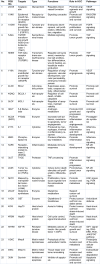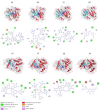Exploring the therapeutic potential of Emblica officinalis natural compounds against hepatocellular carcinoma (HCC): a computational approach
- PMID: 39790561
- PMCID: PMC11713998
- DOI: 10.17179/excli2024-7970
Exploring the therapeutic potential of Emblica officinalis natural compounds against hepatocellular carcinoma (HCC): a computational approach
Abstract
Hepatocellular carcinoma (HCC) is the fifth leading cause of cancer related deaths globally. Despite advancements in treatment, drug resistance and adverse side effects have spurred the search for novel therapeutic strategies. This study aimed to investigate how the Emblica officinalis can inhibit key targets involved in HCC progression. Screening of the reported compounds based on ADMET profile and identification of protein targets was done using the literature survey. Protein targets were divided into four major categories including inflammatory, angiogenic, anti-apoptotic as well as proliferative targets. Gene ontology (GO) and Kyoto Encyclopedia of Genes and Genomes (KEGG) analyses were performed to reveal the functional roles of genes. The STRING database was used to analyze the protein-protein interactions (PPI) of target genes. Docking was employed to predict the binding affinity of compounds with target proteins. Subsequently, MD simulation was conducted to assess the stability and dynamics of protein-ligand complexes. A total of 22 active compounds with 25 protein targets have been identified. These targets have a major role in controlling biological processes such as apoptosis, signaling and cellular interactions. KEGG pathway analysis showed that cancer, atherosclerosis, PI3K-Akt, EGFR tyrosine kinase inhibitor resistance and MAPK signaling pathways are mainly involved. Molecular docking by Mcule platform demonstrated that emblicanin A, punigluconin, penta-o-galloylglucose and quercetin showed higher binding energy affinities with BCL2, BCL2L1, c-Met, HSP70, EGFR, FGFR1, PTGS2 and TNFα. MD simulation revealed conformational changes, flexibility, interactions and compactness of protein-ligand complex. The stable protein binding interactions suggest the potential of compounds to inhibit the functions of target proteins. These results suggest that compounds derived from E. officinalis may have the therapeutic potential for treating HCC. See also the graphical abstract(Fig. 1).
Keywords: MD simulation; angiogenesis, docking; hepatocellular carcinoma (HCC); natural compounds.
Copyright © 2024 Ilyas et al.
Conflict of interest statement
All authors declare that they have no conflict of interest.
Figures













Similar articles
-
Active ingredients and molecular targets of Taraxacum mongolicum against hepatocellular carcinoma: network pharmacology, molecular docking, and molecular dynamics simulation analysis.PeerJ. 2022 Jul 18;10:e13737. doi: 10.7717/peerj.13737. eCollection 2022. PeerJ. 2022. PMID: 35873910 Free PMC article.
-
A Network Pharmacology Approach to Reveal the Underlying Mechanisms of Artemisia annua on the Treatment of Hepatocellular Carcinoma.Evid Based Complement Alternat Med. 2021 Feb 22;2021:8947304. doi: 10.1155/2021/8947304. eCollection 2021. Evid Based Complement Alternat Med. 2021. PMID: 33688369 Free PMC article.
-
Exploring the mechanism of bioactive components of Prunella vulgaris L. in treating hepatocellular carcinoma based on network pharmacology.Chem Biol Drug Des. 2024 Jan;103(1):e14413. doi: 10.1111/cbdd.14413. Epub 2023 Dec 1. Chem Biol Drug Des. 2024. PMID: 38040415
-
Exploring the mechanism of aloe-emodin in the treatment of liver cancer through network pharmacology and cell experiments.Front Pharmacol. 2023 Oct 12;14:1238841. doi: 10.3389/fphar.2023.1238841. eCollection 2023. Front Pharmacol. 2023. PMID: 37900162 Free PMC article.
-
Pharmacological mechanism of quercetin in the treatment of colorectal cancer by network pharmacology and molecular simulation.J Biomol Struct Dyn. 2024 Aug;42(13):7065-7076. doi: 10.1080/07391102.2023.2235589. Epub 2023 Jul 18. J Biomol Struct Dyn. 2024. PMID: 37464874 Review.
References
-
- Ahmed AA-R, Aziza S, Hanaa A. Anti-cancer activity of quercetin, gallic acid, and ellagic acid against HepG2 and HCT 116 cell lines: in vitro. Int J Pharm Bio Sci. 2016;7:584–92.
-
- Asjad HMM, Akhtar MS, Khan M, Sial NT, Sohail I, Arshad L. Ethanolic extract of citrus sinensis peel markedly mitigate paracetamol-induced hepatotoxicity in rats. J Health Rehabil Res. 2023;3:1058–62.
LinkOut - more resources
Full Text Sources
Research Materials
Miscellaneous
